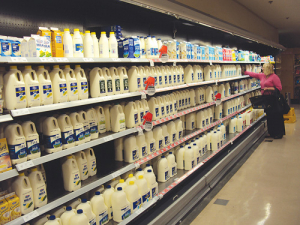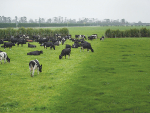Australia's milk production is set to fall significantly in the 2016-17 season due to the damage caused to farm cashflows and industry confidence after the late cuts to milk prices in April this year.
The developing drift from El Nino to La Nina weather will take a while to provide tangible benefits to producers in southern regions, but meanwhile the numbers of cows sent to abattoirs is likely – on early production numbers at least – to take milk output to its lowest point since the mid-1990s.
Much has been written about the profound effects of the cut in milk prices on farmer profitability and the damaged trust in a couple of major milk processors. But there are other larger impacts to come.
Firstly, an adjustment of this magnitude -- 5-10% of national milk output, mostly felt in southern regions -- will push up costs in the supply chain for milk processing and affect the strength of the sector for several years.
Lower factory throughput will reduce plant profitability and keep hurting farmgate prices for all producers.
Secondly, if milk volumes fall below 9 billion litres, the effect will push the domestic share of milk processed closer to 70%.
But does this mean it will change the determinants of farmgate prices, so that the world market will have less influence on milk values? No, that won’t change.
We’re effectively an open market for cheese, butterfat and milk powders and have a large low-cost exporter across the Tasman that views this market as part of its home ground.
Several large multinational groups – fast food chains and large food brands – operate with global sourcing policies, reinforcing the fact that world prices set wholesale prices in the Australian market.
Why is pricing made so tough by food companies? There are no significant segments of the food market in Australia that are immune from price pressure, whether through grocery stores, convenience outlets, fast food or other dining out venues.
Sure, there are niches that create premiums for a limited number of players, but if they get too big they quickly risk being ‘commoditised’.
That brings us to the grocery market, the largest channel to consumers for Australian dairy products, where the operating environment will probably get a little worse.
Australia’s two major supermarket chains posted their 2016 results last month, and the contrast between Coles and Woolworths couldn’t have been greater.
Coles’ ‘trusted value’ pitch to consumers is still the single biggest shaper of the Australian food market, and has worked well for Wesfarmers shareholders.
Coles lifted earnings by only 4% this year, but profitability has grown 60% over the past five years in the midst of a deep-discounting war waged for consumer trust, while it grew its supermarket business sales by 30% on 8% more store numbers. Coles’ underlying business rose 4% on a comparable ‘same-stores’ basis.
But the scariest number for Australian food producers is the underlying food price deflation, which was almost 2% in 2015-16, and has been in deflationary mode since the post-GFC tightening really got underway in 2009.
At the other end of the spectrum, the sustained attack by Coles and the swelling influence of the discounter Aldi finally came home to roost for Woolworths, which reported the unthinkable for a big grocery player -- a fall in sales of its food business. Stagnant sales caused profits to crash, down 40%, as retailing margins collapsed from 7% to 4.5%.
For many years Woolworths has claimed it was defending its world-beating margins yet, in a single year, they fell below Coles which has run a leaner business.
Some analysts have criticised Woolies for keeping prices too high; now the new regime has committed to funding more price cuts. I can hear the bleeding hearts out there asking ‘so why should you care?’ Answer: as the dairy value chain feels the pain of shrinkage, the biggest market for milk just got tighter, if that were possible.
The supermarket stakes will get higher and the long, hard contests between the big three will now drag on as Woolworths attempts a major turnaround.
Meanwhile the economy isn’t getting any better, as household incomes in real terms have been slowing down – suggesting ‘value’ will still be important to many grocery buyers.
Some things might be a little different however. Retail analysts we follow point to signs that the average shopper is getting a little jaded with specials and savings, as discounts are less effective at cutting through and moving traffic between stores and shifting products off the shelves.
Both big chains might have to create more excitement in their brands to draw more cash from purses and wallets.
On the other hand, it is apparent that shoppers and the communitys are taking more notice of how suppliers are being treated; there is a growing realisation that ‘cheap for the sake of cheap’ isn’t a great idea. Let’s see if that gains more traction, or whether the compulsion to follow Aldi is just too great.
• Steve Spencer is a director of Australian food consultancy and analysis company Fresh Agenda.


















